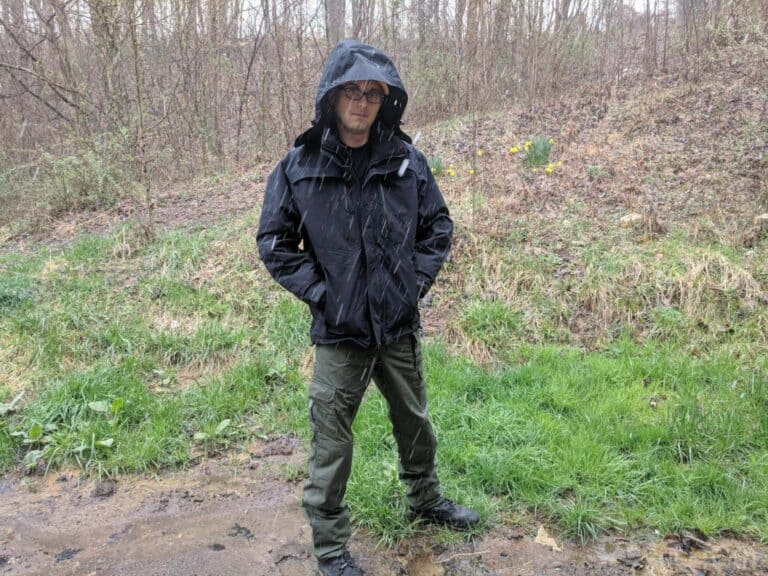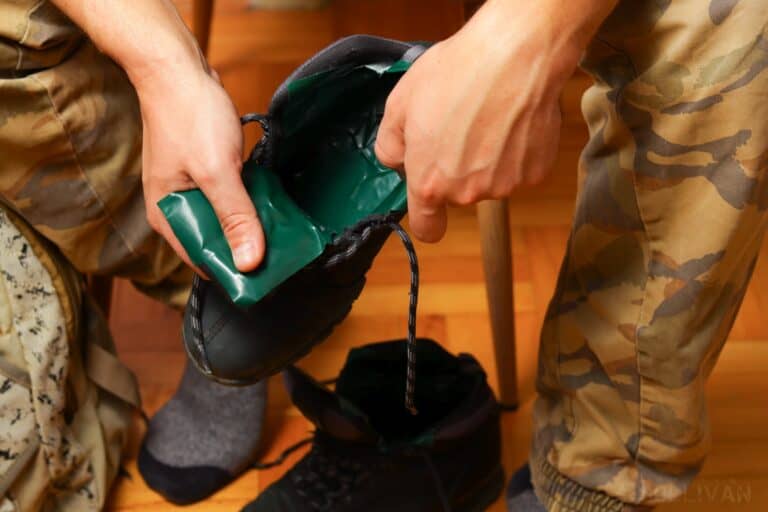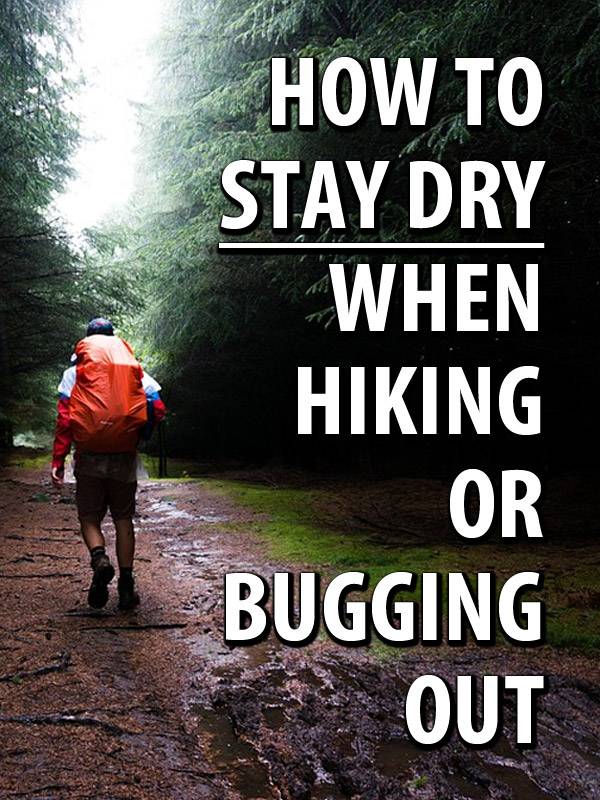Well, I have to admit that, when I think about bugging out in case of an emergency, I almost never imagine that it’s pouring down rain when I have to set out on foot. But what if it is?

What if the weather doesn’t cooperate? What if when it comes time to bug out, your area is being dumped on by Mother Nature in addition to whatever other emergency is happening at the time?
The rest of this article is devoted to how to stay dry when bugging out because we all know that keeping dry and warm can often have a huge impact on your ability to survive a situation if you find yourself stranded.
Table of Contents
The Terminology
One of the first things I think is important to understand, if you don’t already, is the terminology and labeling that comes into play when we’re talking about staying dry. There are three main terms used to label the ability of gear or clothing to stay dry or keep you dry.
- Water Resistant fabric is better than nothing if you’re trapped temporarily in a rainstorm. Water resistant material will not prevent rain molecules from getting through onto your skin or second layer of clothing. So if you aren’t confident that you can get out of an unexpected rainstorm quickly, you’ll want something more about.
- Water Repellent clothing is typically less expensive than waterproof gear or clothing and it works for short-term bug-outs where you can turn back and get out of the rain quickly. It’s usually coated with a solution that repels water. But if you stay in the rain, water will start to bead up on your clothing or gear. When the beading starts, it’s a sign that the water will soon soak through so find a way to get out of the rain.
- Waterproof clothing or gear is more expensive to buy but for good reason. Waterproof gear and clothing is designed to keep you dry. The weave of the fabric is such that even water molecules can’t penetrate it. Buying waterproof gear or clothing should be considered an investment in your health and safety. Without waterproof gear to keep you dry, you could end up cold and damp, the two ingredients that can lead to hypothermia. Some waterproof clothing is woven so tight that it’s not “breathable” which means that you can perspire on the inside and end up damp. Look for Gore-TexⓇ products or other “breathable” waterproof clothing if your budget allows.
Understanding the terms above will help you make the right decisions when it comes to buying gear and clothing that will help you stay safe and dry.
Clothing
Keep Your Feet Dry
Wear a breathable trail running shoe or waterproof hiking shoe. These shoes will dry quickly if they do get wet. They are often softer than boots and more breathable which means you won’t sweat as badly from the inside.
For flatter, even trails or walking on roads, shoes are easier on your legs which means you won’t tire out as quickly. For mountainous trails or uneven territory, use sturdy waterproof or water repellent boots instead to provide more ankle protection and minimize the risk of injury.
Carry at least one pair of dry socks in your backpack
Disclosure: This post has links to 3rd party websites, so I may get a commission if you buy through those links. Survival Sullivan is a participant in the Amazon Services LLC Associates Program. As an Amazon Associate, I earn from qualifying purchases. See my full disclosure for more.
It’s a good idea to invest in socks made with at least 50% merino wool such as socks by DarnTough, Smartwool, Innotree , and Patagonia.
Wool has moisture wicking properties which will help keep your feet dry. Socks made with merino wool will be significantly more expensive but will last a lot longer than traditional cotton or polyester socks.
DIY foot protection
When we were kids, mom used to have use wear zip lock bags or plastic grocery bags over our socks when we put on our winter boots to go outside and play.
I can tell you from experience that this little DIY technique can help keep feet dry and warm when your boots fail.
The only downside is that when used for extended bug-outs you may find your feet will sweat and become damp from the inside out. If you feel your feet begin to sweat, be sure to take a moment to dry them out as soon as it’s feasible.
Another way that works in a pinch is to insulate your boots on the inside with duct tape:

The ability to keep your feet warm at all times when outdoors. Failure to do this effectively can mean blisters and other sores that will negatively impact your mood and morale.
Issues with your feet being cold or wet can even hinder your mobility which can mean the difference between being able to hike out to safety or being forced to shelter overnight outdoors during a storm.
Keep Your Core Dry
Dress in Layers
If you can remember to dress in layers, you will find it easier to stay dry when outdoors. Your base or bottom layer is the layer that is worn against your skin. The base layer should ideally be moisture wicking like Polartec, Coolmax, or Capilene.
Moisture wicking clothing is designed to pull moisture from the skin and push it out from the body to the outer layers where it can evaporate quickly.
This prevents you from getting wet if you sweat or become too hot during a bug out. If you cannot wear moisture wicking clothing, choose a light wool or synthetic blend of materials.
The mid layer is the insulating layer. It’s located between the base layer and your outer layer. It’s designed to trap heat closer to your body and insulate your body from the wet/cold around you. It should be fleece or a wool blend that is breathable and warm.
Over the insulating layer is the outer layer and it’s designed to serve as a windproof and/or waterproof barrier. The outer layer isn’t meant for warmth which is why in colder weather you need the insulating layer. If you are caught in the rain, your outer layer is your first line of defense against getting wet and cold.
Use a good rain jacket with a hood
Keeping your core warm and dry is critical for any wet bug out scenario. Something like the Marmot Minimalist Men’s Rain Jacket is ideal for keeping rain at bay in even the harshest conditions. It includes pit zips for venting which is crucial for keeping you dry on the inside.
Whatever rain jacket you choose, it should ideally have Gore-Tex technology, sturdy zippers, pockets, and an well-fitting, adjustable hood. For jackets with a looser hood, you may want to add a breathable baseball cap with a brim to keep water away from your eyes.
- Storm Surge pants are lightweight with taped seams to prevent any leaks. These are great for warmer climates or seasons. Make sure pant legs are wide enough to go over the top of your boots to prevent rain from sliding down your pants and into your boots.
- Rain Kilts are essentially ultra-light skirts designed to keep the rain off your clothing. They work well with just about any rain jacket and are great for men and women who are plus size or who hate the restrictive feeling of bulkier rain pants.
- Seal any Gaps in Clothing once you’ve chosen your pants and jacket to make sure rain can’t find its way in as you move. Pants and jackets should ideally have taped seams and a drawstring hem and hood. Pay special attention to any gaps at the wrists, waist, and between your boots and pants as this is often where water can get in. If you are caught in an outdoor situation during a storm without the proper gear, use whatever you have on hand to temporarily seal gaps and keep water out.
Keep Your Gear Dry
Buy a waterproof backpack if your budget allows, especially if you will be traveling through an area that is prone to flooding or high water.
Use a waterproof backpack cover to help keep the rain off your backpack if it’s not waterproof. Backpack covers are typically less expensive. Just make sure to pack your backpack so that your most frequently need items are in external pockets within easy reach so you can limit the need to lift the backpack cover and open your pack while in the rain.
Carry waterproof topographic maps whenever possible to ensure that no matter how wet your gear may get, you’ll still be able to navigate your way.
If you can’t afford to buy waterproof maps, you can DIY your own water resistant topographic maps by laminating paper ones or keeping them inside Ziploc bags even when in use to protect them from the rain.
DIY Protection for Your Backpack
If purchasing a waterproof backpack or backpack cover isn’t doable for whatever reason, you can create some DIY protection for your backpack by storing like items together in less expensive dry sacks.
To provide even more protection from the weather, line your entire backpack with a garbage bag, put the dry sacks inside and the attach another garbage bag over the outside of your backpack as a makeshift water-resistant backpack cover.
Create a Makeshift Shelter
Use a water repellent or waterproof tarp to create a temporary shelter until the storm passes. For those who regularly hike or camp in wet climates, you can purchase a “wet weather tent”. Waterproof tents are designed for inclement weather.
They are made from a thicker, denser material and have tight seams to keep water out during extreme weather. Waterproof tents are typically more expensive than a standard camping tent, but they are also more stable and better ventilated.
Get Out of The Rain Quickly
If you do find yourself stranded in an outdoor situation in an unexpected rainstorm, hopefully you’ll have the gear and clothing to keep yourself warm and dry as you continue moving. If you are caught in the rain without the right protective gear, the ideal next step is to get out of the rain quickly.
To dodge the rain, you can duck under the canopy of a leafy tree to keep most of the rain off of you. If you see a natural formation such as caves, a rock overhang, or even a jumble of rocks, you may be able to duck under and stay relatively dry until the storm passes.
Knowing how to stay dry when hiking or bugging out is critical to staying warm, especially when temperatures drop below 60 degrees Fahrenheit (15 Celsius) as hypothermia can set in quickly.
The colder the temperatures, the more crucial it is for you to stay dry or get dry quickly if you do get wet. Depending on where you are, you may need to take time to set up camp, create a temporary shelter and dry out your clothing, including socks and boots, before continuing on.
Do you have a favorite way to stay dry when hiking or bugging out that works for you? Let us know in the comments below.


Born and raised in NE Ohio, with early memories that include grandpa teaching her to bait a hook and watching her mom, aunts, and grandmothers garden, sew, and can food, Megan is a true farm girl at heart.
For Megan, the 2003 blackout, the events of 911, and the increasing frequency of natural disasters like Hurricane Katrina, spurred a desire to be more prepared. Soon to be living off-grid, this mother of four and grandmother of ten is learning everything she can about preparedness, survival, and homesteading.

I don’t believe there is any way to stay dry during a bug-out in the rain. If your outer layer is water-proof, then you will sweat and get wet from within. The only way to stay dry in the rain is to hunker down. Just the act of moving will invariably let water in somewhere. In this scenario, that is not an option. The best we can do then is to wear good quality clothes that wick well and dry fairly quickly. With the proper gear you can “wear it dry” once you get out of the rain. The heat from your body will aid in drying. The layering you described will work well, but I don’t believe you will stay dry, just drier, and you will eventually dry out with that gear. I wear all that stuff, and never stay dry while on the move.
Have you heard of using foam?
http://forums.mtbr.com/fat-bikes/foam-winter-clothing-892582.html
Shaping a large and thick piece into a sleeping bag is another option. If you got soaked, climbing into a homemade foam sack might save your life.
BTW, I’ll trade a bit of sweat to a soaking cold rain, so using a 50 gallon plastic bag as a shelter to ride out a storm would be the first thing I’d try.
Thanks Megan, lotsa help there.
Hello Megan, sounds like you have gotten wet a few times in life…
The idea of wool socks is not only correct with the wear and tear lifetime, cotton socks, (all cotton clothing)
looses your body temperature 26 times faster wet than dry! Wool socks, and clothing, will retain body heat even wet. More expensive, more lifetime, more warm, what could be better??
Baby powder. For underarms, groin and especially in your shoes. Smells better (like a baby), lubricates the shoes and prevents blisters/sores, dries your feet out.
Also, in a Bug Out situation, never take both shoes/boots off at the same time. Takes too long to move out fast if shooting starts. But, take one shoe/boot off, your sock, pour baby powder on your foot and give it a massage. The baby powder will absorb sweat, dry wash your foot, make it smell better and improve the blood circulation all at the same time. After you have pulled on a fresh sock (or air dried used sock) put your shoe/boot back on and repeat for the other impatient foot. Just as good tires are essential for your car, good care is essential for your feet.
By the way, my uncle taught me that POW’s in Vietnam, were, immediately after their capture, very often forced to take off their boots. US soldiers were called “soft feets”. They could not run far
(read: away) without their boots. I therefore walk day and night barefoot to keep my feet fit. If I leave the neighborhood, then I am wearing proper footwear, but ready…Life free, GP